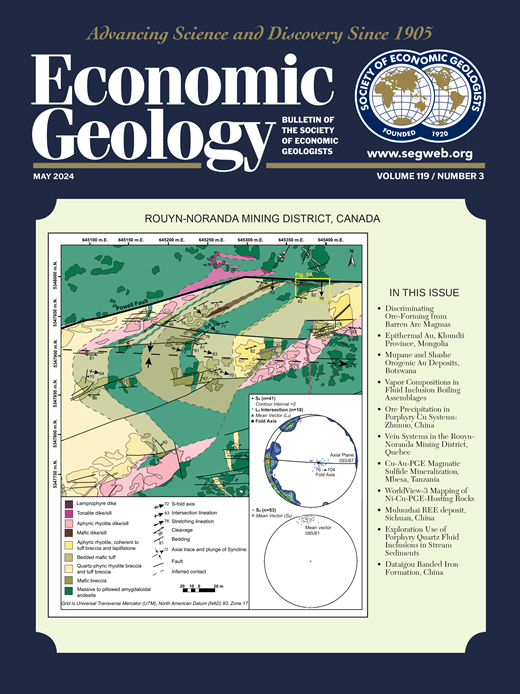Enigmatic High-Tenor Rh-, Ru-, Ir-, and Os-Rich Base Metal Sulfide Mineralization Within the Northern Limb of the Bushveld Complex: A Product of Fractionation of a Sulfide Liquid?
IF 4.9
1区 地球科学
Q1 GEOCHEMISTRY & GEOPHYSICS
引用次数: 0
Abstract
The Base Metal zone at Sandsloot in the Northern limb of the Bushveld Complex, South Africa, is a highly unusual and high-grade Os-Ir-Ru-Rh, Fe-Ni sulfide-rich horizon hosted within the deep Platreef, below the main platinum group element (PGE) horizon. The Base Metal zone ranges from 5 to 100 meters in thickness and is located up to 150 meters beneath the PGE reef. Base metal sulfide mineralization occurs as disseminated/blebby to semimassive/massive sulfides, with a typical assemblage of ~60/25/15 pyrrhotite/pentlandite/chalcopyrite modal %. The Base Metal zone is characterized by high (Os + Ir + Ru + Rh)/(Pt + Pd) ratios that reflect monosulfide solid solution, primitive mantle-normalized PGE profiles. The PGM assemblage is dominated by laurite (RuS2) (62% by area) and iridium-group platinum group element (IPGE) + Pt arsenosulfides (21% by area). The PGE tenors of the sulfides vary between different textural styles, either reflecting R-factor variations or dilution of tenors by addition of crustal S. Disseminated/blebby sulfides have the highest tenors (up to 153 ppm Pd, 249 ppm Rh, 818 ppm Ru), whereas semimassive/massive sulfides have lower tenors (up to 2.8 ppm Pd, 1.8 ppm Pt, 11 ppm Rh, 17 ppm Ru, 2.2 ppm Os, 3.5 ppm Ir). The PGE geochemistry, IPGE-dominant platinum group metal (PGM) assemblage, abundance of Fe sulfides, and high Ni/Cu ratios are consistent with the Base Metal zone representing the monsulfide solid solution portion of a sulfide liquid formed by fractional crystallization. Furthermore, the Cu + Pt + Pd + Au-poor nature of the Base Metal zone suggests that these metals were removed from the Base Metal zone, and some Cu-rich veins and sections are present around the margins of Ni-Fe sulfide to support this. Increasing Pd/Ir and decreasing Rh/Cu ratios downhole indicate the sulfide liquid fractionated downward. Therefore, a residual Cu-rich liquid, with associated Pt + Pd + Au, likely separated from monosulfide solid solution and was mobilized downward and away from the Base Metal zone. Significantly, the mobilization of a Cu-rich liquid leaves the possibility that an undiscovered Cu + Pt + Pd + Au orebody may exist at depth.Bushveld杂岩北缘神秘的高强度Rh、Ru、Ir和os富贱金属硫化物矿化:硫化物液体分馏的产物?
南非Bushveld杂岩北翼Sandsloot的贱金属带是一个非常不寻常的高品位Os-Ir-Ru-Rh, Fe-Ni硫化物丰富的层位,位于Platreef深部,低于主要铂族元素(PGE)层位。贱金属带的厚度从5米到100米不等,位于PGE礁下150米处。贱金属硫化物以浸染状/水泡状至半块状/块状硫化物的形式成矿,典型组合为~60/25/15的磁黄铁矿/镍黄铁矿/黄铜矿模态%。母金属带的特征是高(Os + Ir + Ru + Rh)/(Pt + Pd)比率,反映了单硫化物固溶体,原始的地幔归一化PGE剖面。PGM组合以褐铁矿(RuS2)(62%(面积))和铱族铂族元素(IPGE) +铂砷硫化物(21%(面积))为主。硫化物的PGE次次在不同的结构类型之间变化,要么反映了r因子的变化,要么反映了地壳s的加入对次次的稀释。浸染状/片状硫化物的次次最高(高达153 ppm Pd, 249 ppm Rh, 818 ppm Ru),而半块状/块状硫化物的次次较低(高达2.8 ppm Pd, 1.8 ppm Pt, 11 ppm Rh, 17 ppm Ru, 2.2 ppm Os, 3.5 ppm Ir)。PGE地球化学特征、铂族金属(PGM)组合特征、Fe硫化物丰度特征和高Ni/Cu比值特征与母金属带一致,母金属带代表由分离结晶形成的硫化物液体的单硫化物固溶体部分。此外,母金属带的Cu + Pt + Pd + au贫性质表明这些金属是从母金属带中移除的,并且在Ni-Fe硫化物边缘存在一些富Cu的脉和剖面支持这一点。井下Pd/Ir比值增大,Rh/Cu比值减小,表明硫化物液体向下分馏。因此,残留的富cu液体与伴生的Pt + Pd + Au可能从单硫化固溶体中分离出来,并向下移动并远离母金属区。值得注意的是,富铜液体的动员使得未被发现的Cu + Pt + Pd + Au矿体可能存在于深部。
本文章由计算机程序翻译,如有差异,请以英文原文为准。
求助全文
约1分钟内获得全文
求助全文
来源期刊

Economic Geology
地学-地球化学与地球物理
CiteScore
10.00
自引率
6.90%
发文量
120
审稿时长
6 months
期刊介绍:
The journal, now published semi-quarterly, was first published in 1905 by the Economic Geology Publishing Company (PUBCO), a not-for-profit company established for the purpose of publishing a periodical devoted to economic geology. On the founding of SEG in 1920, a cooperative arrangement between PUBCO and SEG made the journal the official organ of the Society, and PUBCO agreed to carry the Society''s name on the front cover under the heading "Bulletin of the Society of Economic Geologists". PUBCO and SEG continued to operate as cooperating but separate entities until 2001, when the Board of Directors of PUBCO and the Council of SEG, by unanimous consent, approved a formal agreement of merger. The former activities of the PUBCO Board of Directors are now carried out by a Publications Board, a new self-governing unit within SEG.
 求助内容:
求助内容: 应助结果提醒方式:
应助结果提醒方式:


